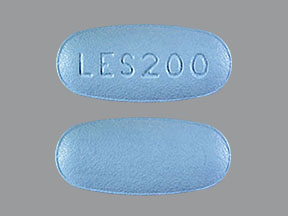Lesinurad Dosage
Applies to the following strengths: 200 mg
Usual Adult Dose for:
Additional dosage information:
Usual Adult Dose for Gout
200 mg orally once a day
Maximum dose: 200 mg per day
Comments:
- Coadminister with a xanthine oxidase inhibitor (e.g., allopurinol or febuxostat); if coadministered with allopurinol, total daily allopurinol doses should not be less than 300 mg (or less than 200 mg with CrCl less than 60 mL/min).
- If xanthine oxidase inhibitor is interrupted, this drug should also be interrupted.
- This drug should not be used to treat asymptomatic hyperuricemia.
Use: Add-on treatment for hyperuricemia associated with gout in patients with elevated serum uric acid despite treatment with a xanthine oxidase inhibitor
Renal Dose Adjustments
CrCl 45 mL/min or greater: No adjustment recommended.
CrCl less than 45 mL/min: Not recommended
CrCl less than 30 mL/min: Contraindicated
- For serum creatinine levels greater than 2 times pretreatment level: Interrupt therapy; do not restart without another explanation for serum creatinine abnormalities.
- If CrCl becomes persistently less than 45 mL/min during therapy, therapy should be discontinued.
Liver Dose Adjustments
Mild to moderate liver impairment (Child-Pugh A to B): No adjustment recommended.
Severe liver impairment (Child-Pugh C): Not recommended.
Precautions
US BOXED WARNING:
- ACUTE RENAL FAILURE: Increased frequency of acute renal failure observed when this drug was given as monotherapy. This drug should be used in combination with a xanthine oxidase inhibitor.
Safety and efficacy have not been established in patients younger than 18 years.
Consult WARNINGS section for additional precautions.
Dialysis
Contraindicated
Other Comments
Administration advice:
- Take orally once a day in the morning with food and water
- Take morning dose at same time as morning dose of xanthine oxidase inhibitor (XOI)
- Patients should stay well hydrated (e.g., 2 liters of liquid per day)
- If a dose is missed, skip the missed dose; do not double the dose.
- If XOI treatment is stopped, this drug should be stopped.
Storage requirements:
- Protect from light
General:
- This drug should not be used to treat asymptomatic hyperuricemia or as monotherapy.
- Gout flares may occur due to increased urate mobilization from tissue deposits, especially during initiation; gout flare prophylaxis is recommended according to practice guidelines.
- If gout flares occur during treatment, manage concurrently; discontinuation of this drug should not be necessary.
- This drug is not expected to be effective in patients with severe renal impairment, end stage renal disease, or on dialysis.
Monitoring:
- Serum creatinine levels should be obtained at baseline and periodically during treatment; in patients with CrCl of 45 to less than 60 mL/min or serum creatinine 1.5 to 2 times pretreatment levels, more frequent monitoring is advised.
- Serum creatinine should be promptly assessed in patients reporting signs/symptoms of acute uric acid nephropathy (e.g., acute flank pain, nausea, vomiting).
Patient advice:
- Instruct patients to keep well hydrated while using this drug (e.g., 2 L fluid per day).
- Inform patients that gout flares may occur, and they should not stop taking this drug if a gout flare occurs.
- Patients should be instructed to report signs/symptoms of acute nephropathy to health care provider.
- Patients should be advised to speak to healthcare provider if pregnant, intend to become pregnant, or are breastfeeding; patients using hormonal contraception to prevent pregnancy will need to speak with their health care provider about using a non-hormonal back-up method of birth control during therapy.
More about lesinurad
- Check interactions
- Compare alternatives
- Reviews (2)
- Side effects
- During pregnancy
- Drug class: antihyperuricemic agents
Patient resources
Other brands
Professional resources
Other brands
Related treatment guides
Further information
Always consult your healthcare provider to ensure the information displayed on this page applies to your personal circumstances.

